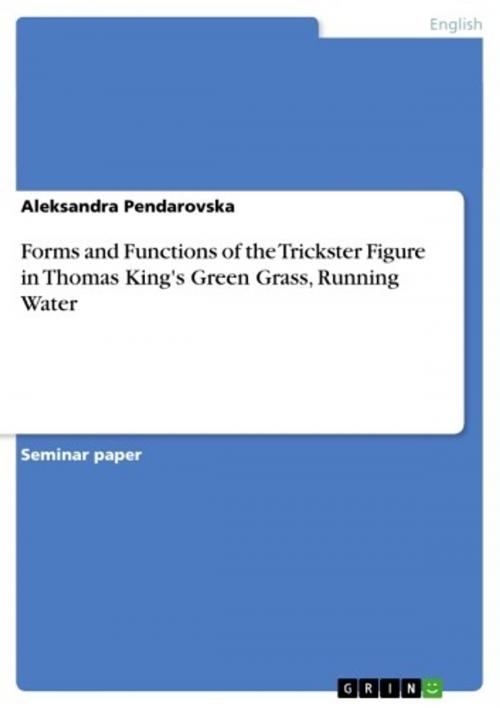Forms and Functions of the Trickster Figure in Thomas King's Green Grass, Running Water
Fiction & Literature, Literary Theory & Criticism, British| Author: | Aleksandra Pendarovska | ISBN: | 9783638298537 |
| Publisher: | GRIN Verlag | Publication: | August 6, 2004 |
| Imprint: | GRIN Verlag | Language: | English |
| Author: | Aleksandra Pendarovska |
| ISBN: | 9783638298537 |
| Publisher: | GRIN Verlag |
| Publication: | August 6, 2004 |
| Imprint: | GRIN Verlag |
| Language: | English |
Seminar paper from the year 2004 in the subject English Language and Literature Studies - Literature, grade: 2 (B), University of Cologne (English Seminar), language: English, abstract: Thomas King´s novel Green Grass, Running Water distinguishes itself from most of the modern novels, above all, from the novels written by Native American authors, in its genuine form and content. Not only the synthesis of oral and written form of narrating stories makes it a valuable literary work that reveals evidence for the existence of a relatively, if not utterly unknown culture, but also the author´s effort to depict characters and stories from the mythology of the Native Americans contribute to it. The central figure among the mythological figures from the Native American culture in the novel Green Grass, Running Water is, by all means, the figure of Coyote. A lot of research has been conducted on the importance of this figure in the Native American mythology, on its meaning in Thomas King´s novel and on the combination of these two aspects. It could be regarded that Thomas King attempts through his characters to illustrate on a larger scale the relationship between two diverse entities and their unequal position in it. This argument has been considered to a large extent by many authors and academics, among which Herb Wyile presents the following point in his article ' 'Trust Tonto' Thomas King´s subversive fictions and the politics of cultural literacy. 'Given these various elements, it might be tempting initially to describe his work as blending Western literary forms with forms from Native cultures. A more appropriate characterization, however, can be found in Kimberley Blaeser's description of the trickster figure in Native writing as '[n]ot a composite, which is made up of distinct and recognizable parts, but a complex, which is one unit whose makeup is intricate and interwoven' ('Trickster' 51). Her description applies nicely to King's writing, since in those Native cultures (and King's writing as an extension of them), that blending or syncretism is already there, because of the cross-fertilization historically and currently between different tribal traditions and because of the legacy of the history of colonialism, during which cultural interaction was imposed.'1 In the light of the opinion presented in the above written quotation this paper will concentrate on the analysis of the meaning and form of the pivotal figure in Thomas King's novel Green Grass, Running Water - the trickster figure of Coyote and attempt to discover the intertwined intertextuality in the dialogs, in which Coyote takes part.
Seminar paper from the year 2004 in the subject English Language and Literature Studies - Literature, grade: 2 (B), University of Cologne (English Seminar), language: English, abstract: Thomas King´s novel Green Grass, Running Water distinguishes itself from most of the modern novels, above all, from the novels written by Native American authors, in its genuine form and content. Not only the synthesis of oral and written form of narrating stories makes it a valuable literary work that reveals evidence for the existence of a relatively, if not utterly unknown culture, but also the author´s effort to depict characters and stories from the mythology of the Native Americans contribute to it. The central figure among the mythological figures from the Native American culture in the novel Green Grass, Running Water is, by all means, the figure of Coyote. A lot of research has been conducted on the importance of this figure in the Native American mythology, on its meaning in Thomas King´s novel and on the combination of these two aspects. It could be regarded that Thomas King attempts through his characters to illustrate on a larger scale the relationship between two diverse entities and their unequal position in it. This argument has been considered to a large extent by many authors and academics, among which Herb Wyile presents the following point in his article ' 'Trust Tonto' Thomas King´s subversive fictions and the politics of cultural literacy. 'Given these various elements, it might be tempting initially to describe his work as blending Western literary forms with forms from Native cultures. A more appropriate characterization, however, can be found in Kimberley Blaeser's description of the trickster figure in Native writing as '[n]ot a composite, which is made up of distinct and recognizable parts, but a complex, which is one unit whose makeup is intricate and interwoven' ('Trickster' 51). Her description applies nicely to King's writing, since in those Native cultures (and King's writing as an extension of them), that blending or syncretism is already there, because of the cross-fertilization historically and currently between different tribal traditions and because of the legacy of the history of colonialism, during which cultural interaction was imposed.'1 In the light of the opinion presented in the above written quotation this paper will concentrate on the analysis of the meaning and form of the pivotal figure in Thomas King's novel Green Grass, Running Water - the trickster figure of Coyote and attempt to discover the intertwined intertextuality in the dialogs, in which Coyote takes part.















